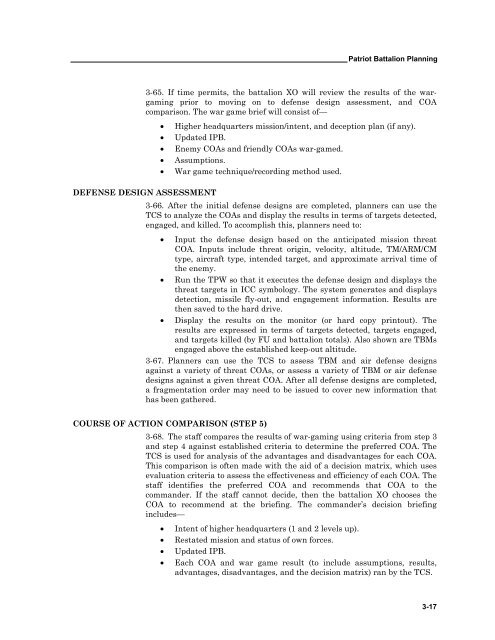FM 3-01.85: Patriot Battalion and Battery Operations - BITS
FM 3-01.85: Patriot Battalion and Battery Operations - BITS
FM 3-01.85: Patriot Battalion and Battery Operations - BITS
Create successful ePaper yourself
Turn your PDF publications into a flip-book with our unique Google optimized e-Paper software.
<strong>Patriot</strong> <strong>Battalion</strong> Planning<br />
3-65. If time permits, the battalion XO will review the results of the wargaming<br />
prior to moving on to defense design assessment, <strong>and</strong> COA<br />
comparison. The war game brief will consist of—<br />
DEFENSE DESIGN ASSESSMENT<br />
Higher headquarters mission/intent, <strong>and</strong> deception plan (if any).<br />
Updated IPB.<br />
Enemy COAs <strong>and</strong> friendly COAs war-gamed.<br />
Assumptions.<br />
War game technique/recording method used.<br />
3-66. After the initial defense designs are completed, planners can use the<br />
TCS to analyze the COAs <strong>and</strong> display the results in terms of targets detected,<br />
engaged, <strong>and</strong> killed. To accomplish this, planners need to:<br />
Input the defense design based on the anticipated mission threat<br />
COA. Inputs include threat origin, velocity, altitude, TM/ARM/CM<br />
type, aircraft type, intended target, <strong>and</strong> approximate arrival time of<br />
the enemy.<br />
Run the TPW so that it executes the defense design <strong>and</strong> displays the<br />
threat targets in ICC symbology. The system generates <strong>and</strong> displays<br />
detection, missile fly-out, <strong>and</strong> engagement information. Results are<br />
then saved to the hard drive.<br />
Display the results on the monitor (or hard copy printout). The<br />
results are expressed in terms of targets detected, targets engaged,<br />
<strong>and</strong> targets killed (by FU <strong>and</strong> battalion totals). Also shown are TBMs<br />
engaged above the established keep-out altitude.<br />
3-67. Planners can use the TCS to assess TBM <strong>and</strong> air defense designs<br />
against a variety of threat COAs, or assess a variety of TBM or air defense<br />
designs against a given threat COA. After all defense designs are completed,<br />
a fragmentation order may need to be issued to cover new information that<br />
has been gathered.<br />
COURSE OF ACTION COMPARISON (STEP 5)<br />
3-68. The staff compares the results of war-gaming using criteria from step 3<br />
<strong>and</strong> step 4 against established criteria to determine the preferred COA. The<br />
TCS is used for analysis of the advantages <strong>and</strong> disadvantages for each COA.<br />
This comparison is often made with the aid of a decision matrix, which uses<br />
evaluation criteria to assess the effectiveness <strong>and</strong> efficiency of each COA. The<br />
staff identifies the preferred COA <strong>and</strong> recommends that COA to the<br />
comm<strong>and</strong>er. If the staff cannot decide, then the battalion XO chooses the<br />
COA to recommend at the briefing. The comm<strong>and</strong>er’s decision briefing<br />
includes—<br />
Intent of higher headquarters (1 <strong>and</strong> 2 levels up).<br />
Restated mission <strong>and</strong> status of own forces.<br />
Updated IPB.<br />
Each COA <strong>and</strong> war game result (to include assumptions, results,<br />
advantages, disadvantages, <strong>and</strong> the decision matrix) ran by the TCS.<br />
3-17
















